When looking into Scottish recipes to make at home, I was amazed to find that you can make a traditional Scottish petticoat tails shortbread recipe with only three ingredients, so I had to give it a try!
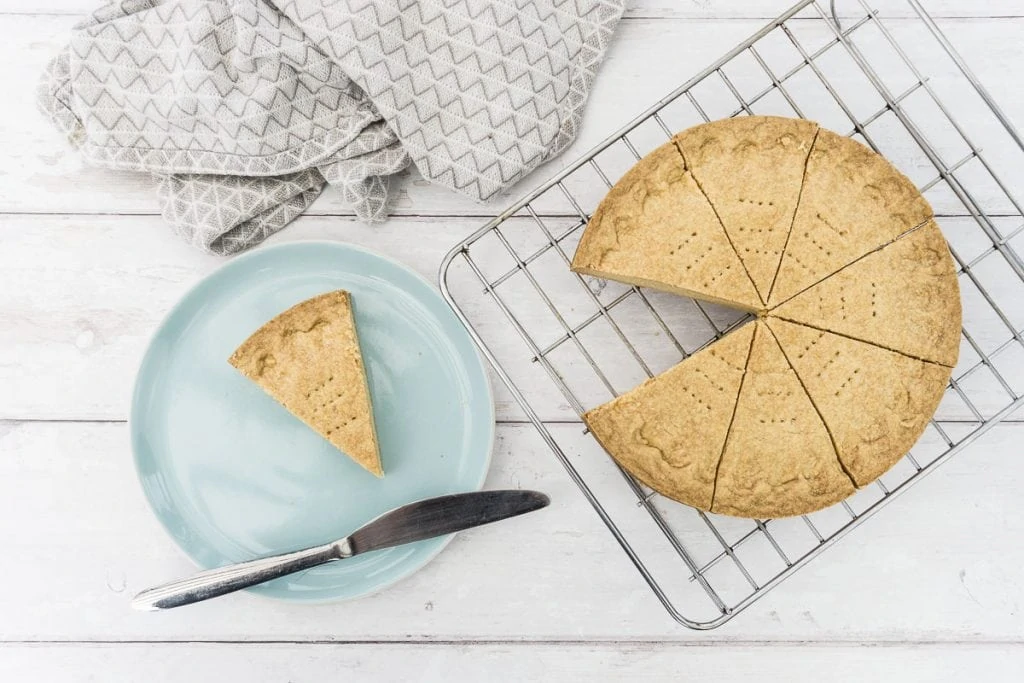
Shortbread is traditionally associated with Scotland, and although the original recipe often only calls for three ingredients, more modern recipes have changed that up a bit.
It was also made as one round large cake or that was cut after baking into “petticoat tails”, rather than being baked as separate shortbread cookies/biscuits like many recipes today are.
Shortbread is something we always had about the house at Christmas. My Mum often made a batch or we would buy it in Christmas tins with Scottish themes. I was excited to give making shortbread a go for myself!
It took me a couple of tries to get it right, so below I’ve detailed some of my best facts, tips and methods for getting this petticoat tails shortbread recipe right the first time, followed by the recipe in full at the end of the post.
Scroll down for a printable recipe card and video on how to make this recipe!
- Why is it called Shortbread?
- Is Shortbread Scottish?
- Things you'll need to make Petticoat Tails Shortbread
- What tin to use for Petticoat Tails Shortbread
- Ingredients for Petticoat Tails Shortbread recipe
- How to make petticoat tails shortbread – Step-by-step method
- How long does homemade shortbread last?
- Variations to this basic shortbread recipe
- Other Recipes to Try:
Why is it called Shortbread?
“Short” refers to an old word meaning a crumbly texture in cooking and baking, and it’s the large amount of butter used that makes it this way. For example, there is also shortcrust pastry that’s made with lots of butter.
Shortbread was originally called “biscuit bread” as it was made from leftover bread dough that would be dried out in the oven. Thankfully, over time butter replaced the yeast and what we now know as delicious shortbread was born!
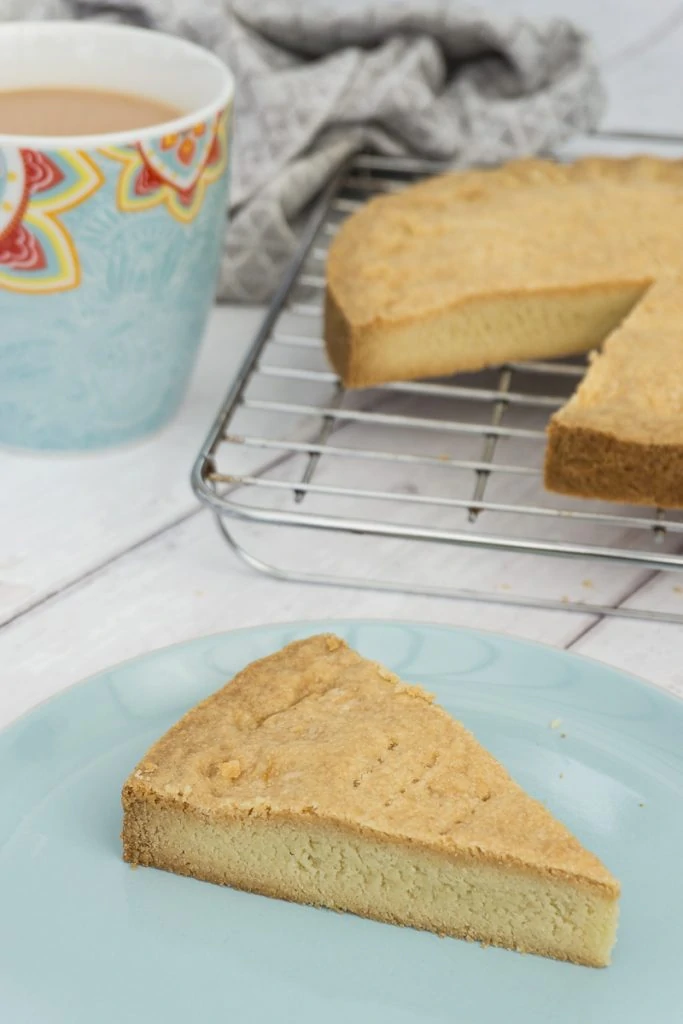
Is Shortbread Scottish?
Although “Biscuit Bread” was made all over the British Isles from about the 12th century, it was Mary Queen of Scots who popularised shortbread in the 16th century and in particular, the petticoat tails shortbread I’ve made in this recipe.
They’re thought to be called petticoat tails because the triangle biscuits resemble a petticoat! Other traditional shortbread shapes include “rounds” which are individual biscuits cut from a log of shortbread dough and baked separately, and fingers which are cut from a large square or rectangle after baking.
When shortbread began to be exported around the world, Scottish shortbread was some of the finest and it has become synonymous with Scotland.
Because of the amount of butter used to make shortbread it was, at first, usually only made for special occasions like weddings, Christmas, or Hogmanay (Scottish New Year).
If you ever visit Scotland at Christmas you’ll still see shortbread tins for sale in abundance! But now you can enjoy it all-year-round with this recipe too!
Things you’ll need to make Petticoat Tails Shortbread
- Loose bottomed cake tin
- Rolling pin
- Large mixing bowl
- Whisk – electric or hand
- Wooden mixing spoon
- Sifter
What tin to use for Petticoat Tails Shortbread
I use a loose-bottomed cake tin for this shortbread recipe, but you can also use springform. Mine is 8 inches which gives a thick shortbread, but you can use a 9-inch tin for a slightly thinner one.
The other option is to use a fluted tart tin. Just make sure it also has a loose bottom so you can easily remove the shortbread.
Ingredients for Petticoat Tails Shortbread recipe
- 300g Plain Flour (2 Cups)
- 200g-225g Butter (1 Cup)
- 100g Caster Sugar (1/2 Cup)
- Pinch of salt (optional)
This petticoat tails shortbread recipe uses only 3 ingredients! Flour, butter, of course, and caster sugar in a 3:2:1 ratio. Essentially, you need about three parts flour, two parts butter, and one part sugar.
You’ll find that all shortbread recipes use these three ingredients as their base, but from there they can be varied depending on the texture or flavour that they’re trying to achieve.
I’ve decided to keep it simple this time but I can’t wait to try some variations in the future! Including a caramel shortbread recipe I’ve spied in an old recipe book we found…
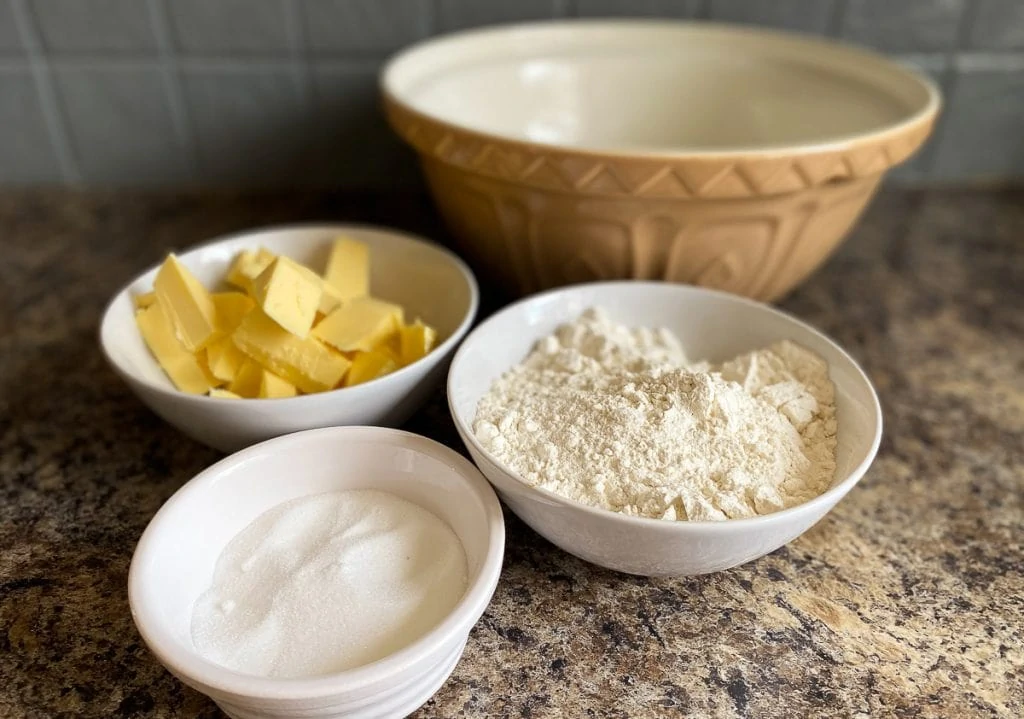
Flour
All-purpose plain flour is the basis of a shortbread recipe. However, instead of using 100% plain flour you might like to substitute about a third of it for cornflour. This will make the final biscuit more crumbly.
Some people also use rice flour instead of cornflour. Both of these options can help the shortbread to hold its shape more, which is important if you want to cut it into shapes to be baked individually.
Since we’re focussing on a petticoat tails design, we’re just going to use plain flour.
Sugar
Using a finer-textured sugar is best for shortbread, which is why the recipe calls for caster sugar. If you can’t get this, you can blitz regular sugar in a food processor to make it finer.
You can also substitute all or part of the sugar for icing sugar/powdered sugar, which is often done in more modern recipes. This gives the shortbread a softer texture.
Butter
The unique and moreish taste of shortbread comes primarily from the butter, so using a good quality butter is a must! It’s up to you whether you prefer to use salted or unsalted butter.
Personally, I like the slightly salty taste salted butter provides and I also add a pinch of salt to the recipe to help bring out the flavour. This is obviously to taste though, you can use unsalted butter and just add a little salt yourself if you require it, or none at all.
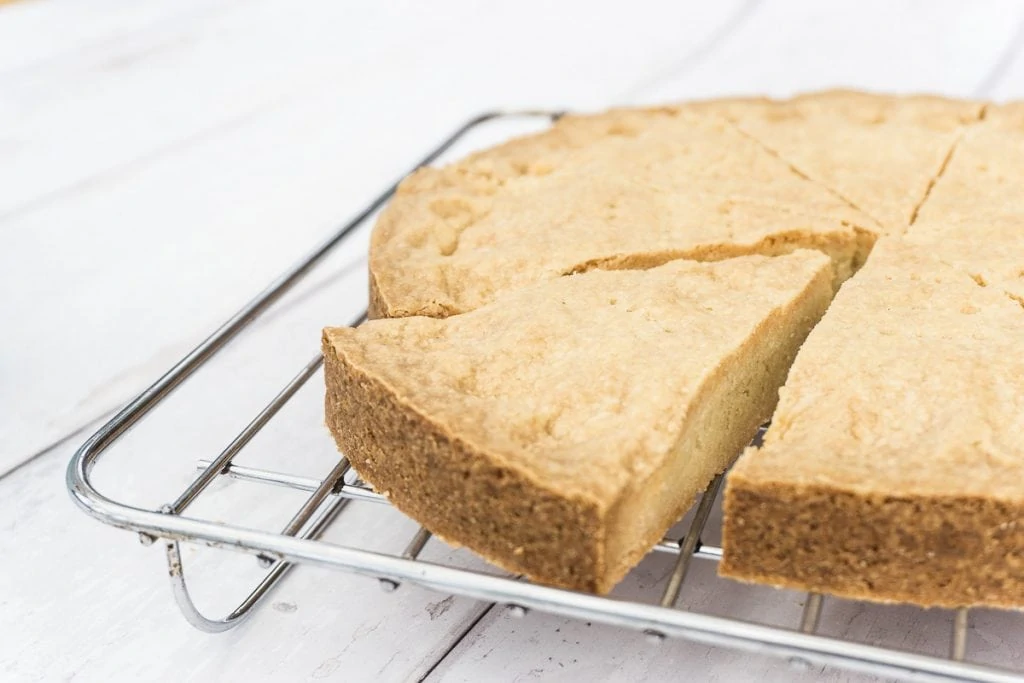
Ingredient ratios
For this bake, I wanted to stick to a traditional three-ingredient shortbread recipe. I find it’s better to discover and learn a recipe in its original form and then enjoy making variations to it at a later date!
After some research, I found the most traditional shortbread recipes called for only plain flour, butter, and caster sugar in the 3:2:1 shortbread recipe method.
The first time I made the recipe, I used “cups” for the measurements rather than grams, which made a buttery soft and delicious shortbread. Usually we also use a scale for measurements in our recipes because this gives a more accurate result.
The second time around, I tried it with grams (300:200:100) and although this also worked and the shortbread kept its shape and design, I would say that somewhere between the two is the perfect mix!
The main difference is the butter, with the cups giving you a little bit extra butter. That’s why you’ll find the recipe card below says 200-225 of butter.
The easiest way to figure this out is to cream 225 and then remove a little (a couple of tablespoons should do it) to set aside and only add back in if the mixture is really dry.
How to make petticoat tails shortbread – Step-by-step method
Below are a few tips and step-by-step photos that will help you get the perfect shortbread rounds and petticoat tails!
The biggest issue with shortbread is that it will spread in the oven and not retain its shape. While shortbread without a pretty design on the top will taste just as good, it may not look quite as impressive and after all, we do eat with our eyes first!
All of the below steps will help you to get a final product that looks as good as it tastes!
The first step is creaming the butter, and right from the beginning, you want to make sure that you don’t incorporate too much air into the mixture or else it will spread more during baking.
Beat the butter until just creamy, but not fluffed up.
The second step is adding the sugar, and at this point, you can also add salt if you want to but this is not essential.
Once again, delicately mix in with minimal effort until only just combined. The sugar should dissolve slowly into the butter, which is why using fine sugar is best.
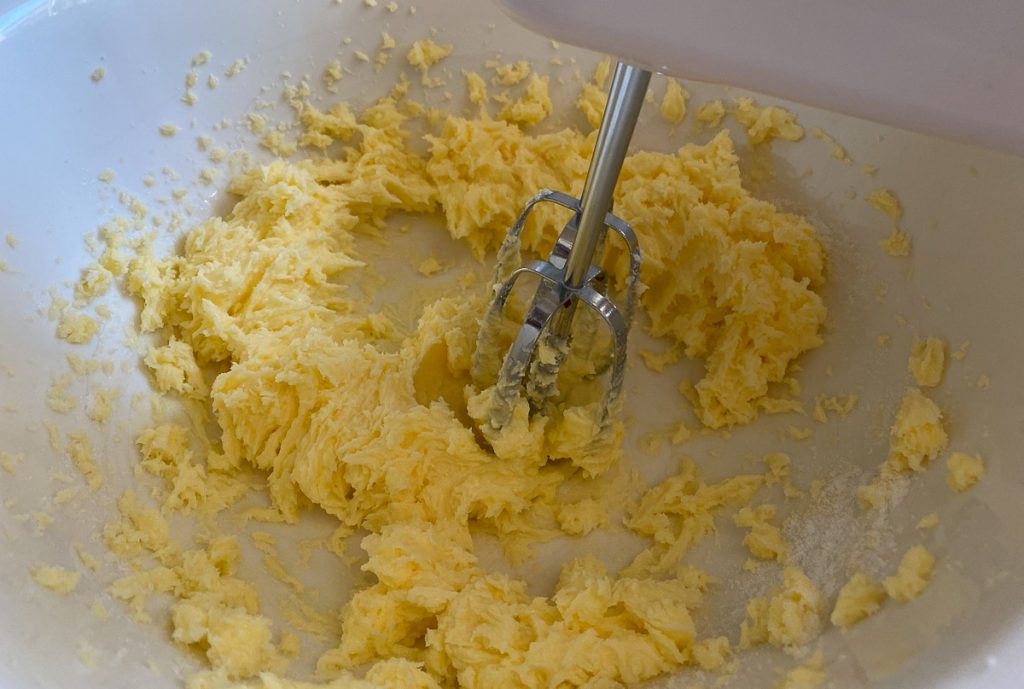
Thirdly, add the flour, we use a sifter at this point. Make sure you mix the flour in with as little effort as possible until it’s just combined and has formed clumps. If you’re using a mixer, you should use it on as low a setting as possible; better still do this by hand.
From this point, it’s time to get your hands dirty! Use your hands to bring the dough together, but don’t overwork it and try and use your hands as little as possible. You’re not making bread!
Just gently fold it together and then tip it out onto your worktop or board to form a ball.
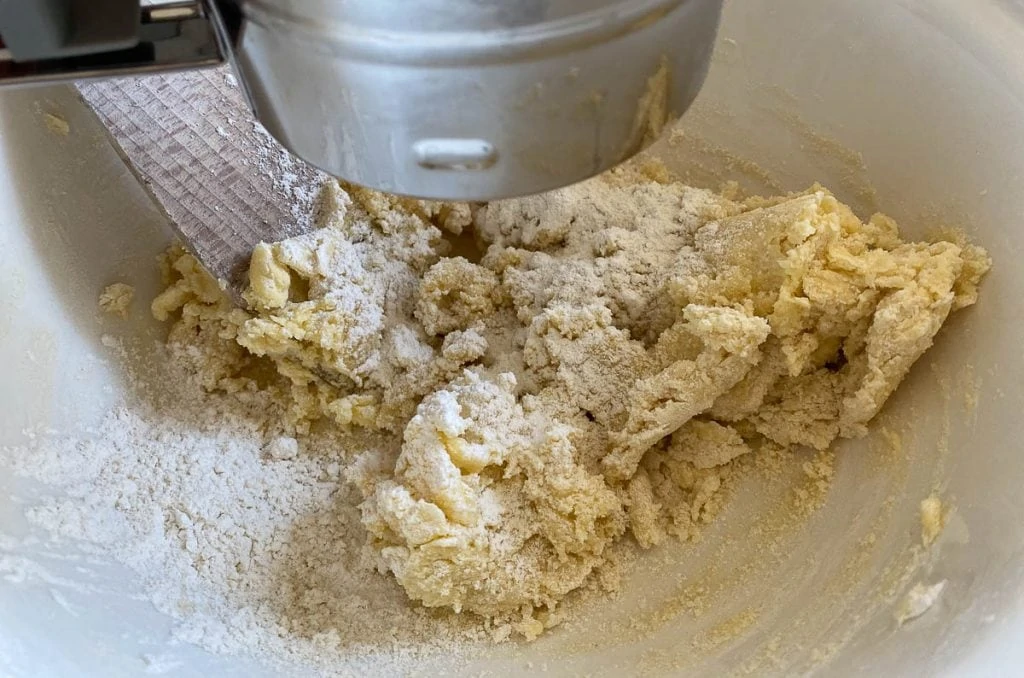
You might find it’s really not coming together at all. In this case you may need to add some extra butter, or even a couple of drops of water.
However, sometimes I also just tip it into the tin crumbly as once you start to push it down and smooth it over with a spoon it’ll come together!
If you decide you want to make separate shortbread cookies/biscuits then you can roll out the dough and use a cookie cutter to make the shapes, but I prefer to keep the shortbread together and slice after cooking in the traditional way.
I used an 8 inch circular tin to make my shortbread round, which gives you quite a thick biscuit at around 1 inch. If you use a 9 inch tin then you’ll get a slightly thinner biscuit.
Once you have roughly shaped the dough into a round you can press it into the tin. There’s no need to grease the tin because of the amount of butter in the shortbread already. Try to ensure the mixture is the same thickness across the tin.
Throughout this whole process remember you should be working/handling the dough as little as possible!
Now you can add a design to the top of the shortbread. I pressed my thumb into the outside of the dough around the edge to provide the frills to my petticoat, so to speak!
I then sliced it with a knife into eight pieces and pricked each with a fork. You can also use a toothpick.
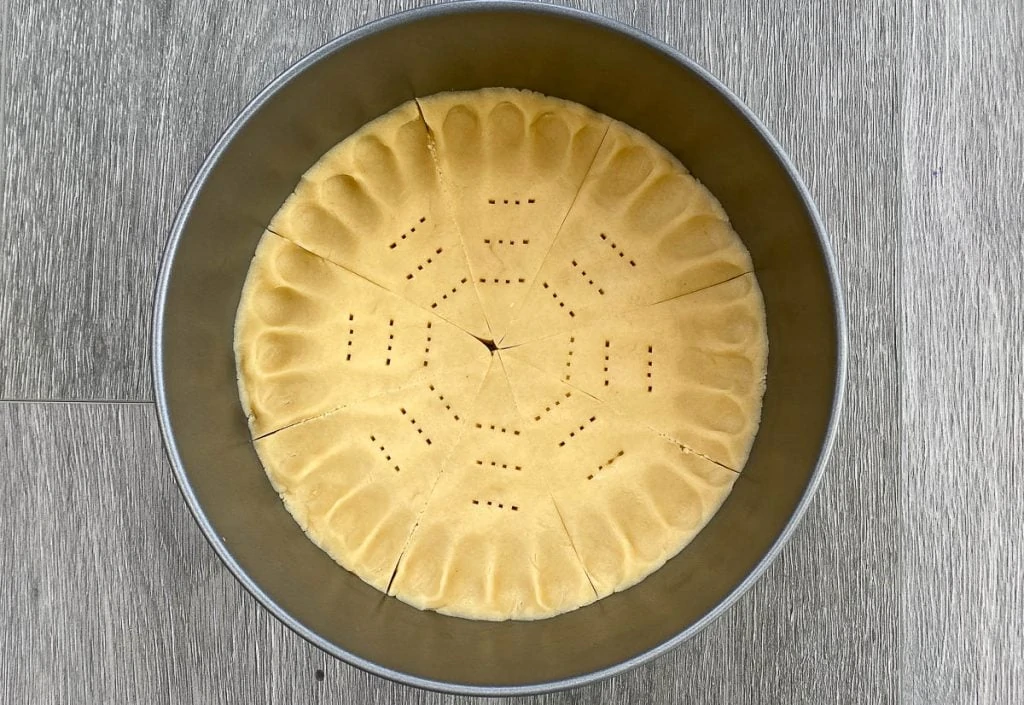
To help keep the design you should now chill it for at least 30 minutes in the fridge.
This especially applies if you’ve cut the shortbread into separate cookies! In that case, you should also put them on a chilled tray for baking and bake at a slightly higher temperature to minimise spreading.
For the petticoat tails shortbread round, you need to bake it for a long time at a low temperature. Depending on the tin size you use, you’ll need around 45-60 minutes.
They should start to brown lightly on top. Unfortunately, I let this batch go just a tad too long!
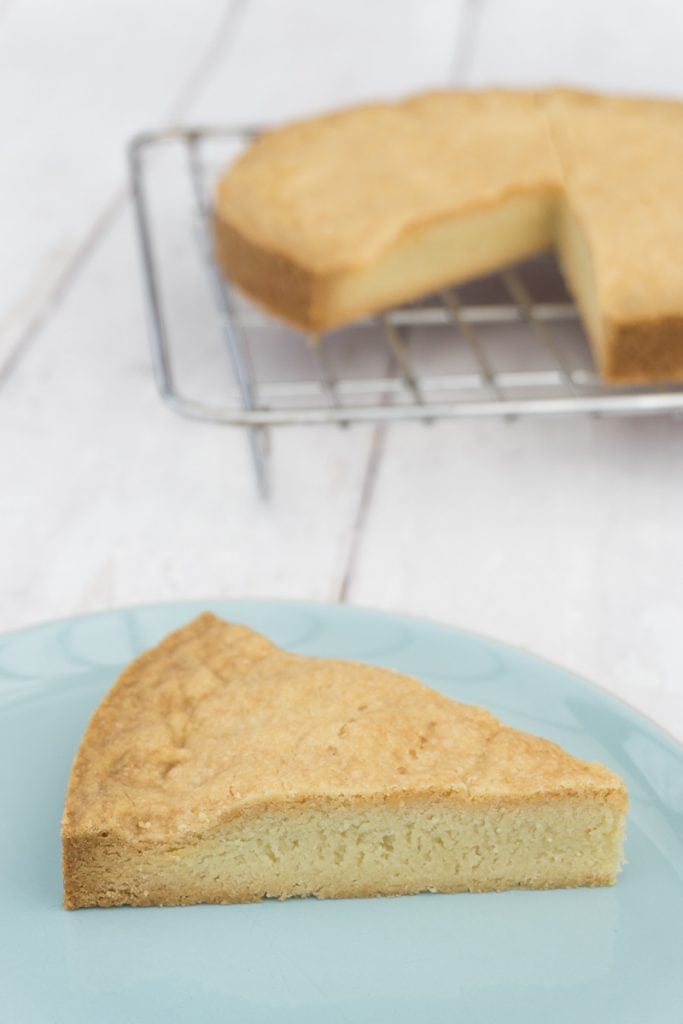
When you take the shortbread out of the oven, immediately run a knife along the previous cuts. If you like, you can also re-use the fork to make the holes a little more pronounced.
Leave the shortbread to cool in the tin and then carefully separate out into individual “petticoats”!
And it’s as simple as that, all you need now is a nice cup of tea to enjoy it with!
How long does homemade shortbread last?
You can keep homemade shortbread in an airtight container for up to 4 weeks, although ours has never lasted that long!
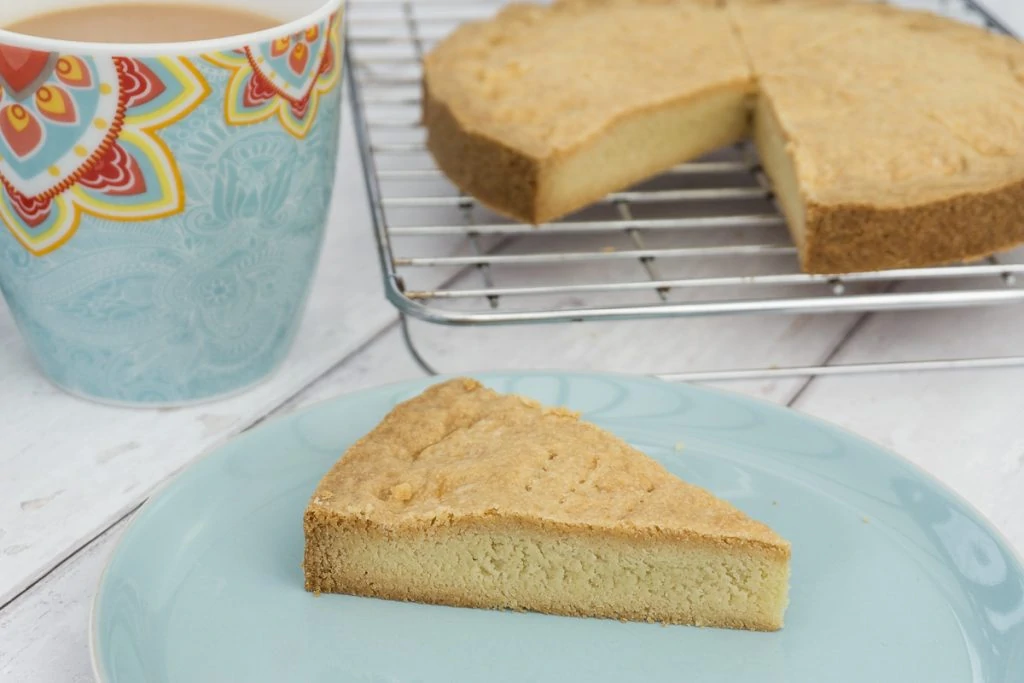
Variations to this basic shortbread recipe
You can do a few things to change up this traditional shortbread recipe if you like.
As previously mentioned, you could try substituting part of the flour for corn flour, rice flour, or even almond flour.
You can also substitute the caster sugar for powdered sugar.
Adding nuts or a flavouring to your shortbread is also possible. Mary Queen of Scots liked hers with caraway seeds! Add essence to the butter when you add the sugar.
And finally, you can also dip your shortbread in chocolate for a little extra indulgence. If you want to take it to the next level try it as part of our Empire Biscuit recipe or if you’d like to try some other traditional Scottish biscuits, try Scottish Perkins Biscuits Recipe, or Classic Abernethy Biscuits Recipe.
I really hope you like my shortbread. If you decide to make this tasty treat, share a picture with me. I’d love to see how yours turned out.
Remember, don’t leave it in the oven too long like I did!
Petticoat Tails Shortbread Recipe
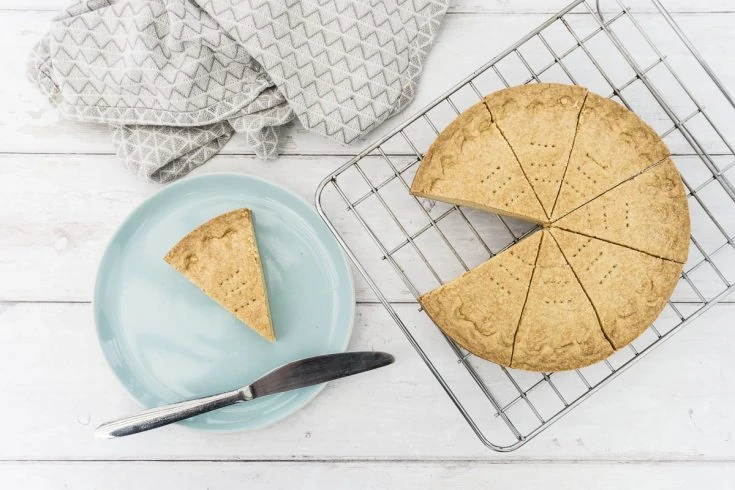
This petticoat tails shortbread recipe uses just three ingredients and the traditional method of baking the shortbread in a round and cutting it into individual slice afterwards.
Ingredients
- 300g Plain Flour (2 Cups)
- 200g-225g Butter (1 Cup)
- 100g Caster Sugar (1/2 Cup)
- Pinch of salt (optional)
Instructions
- Place the butter in a large bowl and mix until just creamed but not fluffy
- Add in the sugar and pinch of salt (optional) and mix until just combined
- Add the flour and mix slowly until clumps are just formed
- Use your hands to gently fold the mixture into a ball, taking care to work the dough as little as possible
- Press into the tin, cut into eight slices and create a design on top with your fingers and a fork/toothpick if you like
- Chill for at least 30 minutes in the fridge, preferably one hour
- Bake at 160C or 325F in a pre-heated fan-assisted oven for 45-60 minutes, depending on the size of the tin. The shortbread should be lightly browned when done.
- Remove the cake from the oven and run a knife along the previous cuts while it's still hot. Release the springform tin's edge and allow it to cool before removing the bottom.
Notes
The amount of butter needed depends on the quality and how much you handle the mixture. Start with approximately 200 grams but if the mixture seems dry you may need to add a little more. It's easiest to do this by creaming 225 grams and then removing a little to set aside in case you need it.
We like our shortbread with salted butter to add a little bite but this is optional.
For shortbread petticoat tails a round tin is preferable. Use an 8-inch tin for 1-inch thick shortbread or a 9-inch tin for a slightly thinner biscuit. If you don't have a round tin you can use square and cut into squares. A springform tin is best because this allows you to remove the sides and then carefully take the shortbread off the bottom of the tin piece by piece.
Take care not to mix or handle the dough too much at any point and chill for at least 30 minutes before baking to avoid the dough spreading during the baking process.
Nutrition Information:
Yield:
8Serving Size:
1Amount Per Serving: Calories: 364Total Fat: 21gSaturated Fat: 13gTrans Fat: 1gUnsaturated Fat: 6gCholesterol: 54mgSodium: 178mgCarbohydrates: 41gFiber: 1gSugar: 13gProtein: 4g
The nutritional data in this recipe is provided by a third party and these values are automatically calculated and offered for guidance only. Their accuracy is not guaranteed.
Other Recipes to Try:
- Millionaire’s Shortbread
- Millionaire’s Cheesecake – Use this recipe as a base!
- We combine this with our Homemade Mincemeat Recipe for a Mincemeat Shortbread Slice!
- Simple Spiced Christmas Shortbread Recipe
Phil and Sonja x
Pin for later!
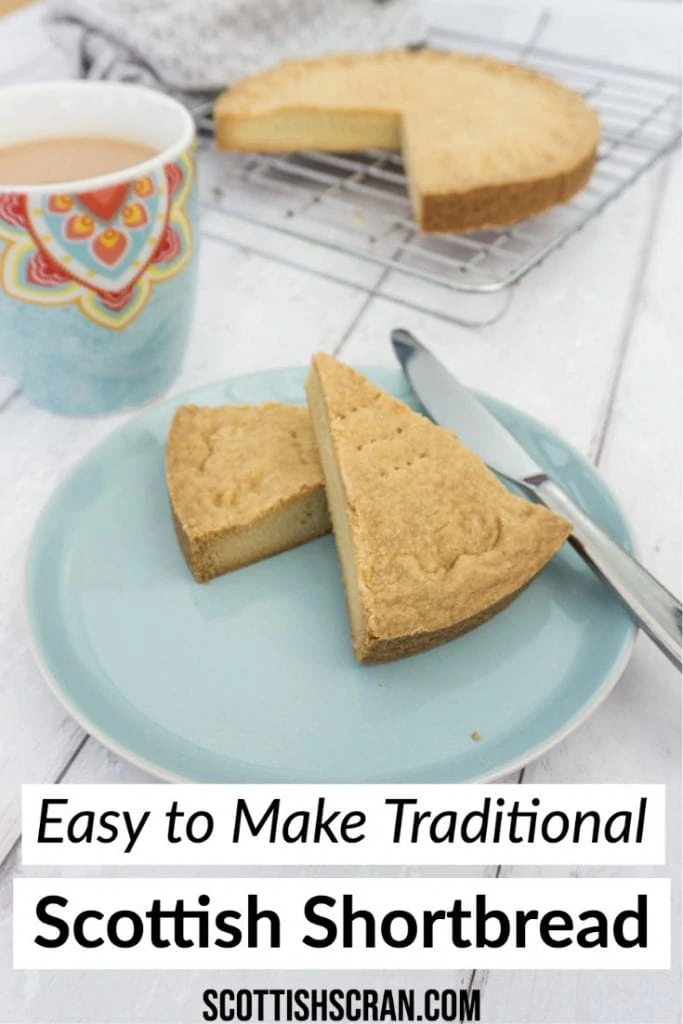

This sounds nice and easy to make especially cooking it in a tin and then cutting, it would save a lot of time not having to cut shapes first. This petticoat shape looks great too, a nice slab of shortbread 🙂
This looks delicious, I can’t wait to try making it! 🙂
We hope it went well for you and you enjoyed it!
Great recipe and even greater website. I’ve been baking loads since lockdown and this will be my next attempt. Thanks so much for sharing and all the very best to you from Kent.
Thank you very much, Kerry, that’s very kind of you! We know Kent well, do say hello to it for us, especially Sittingbourne.
I followed the recipe but the mixture won’t hold together it is too crumbly. Cant roll it out. Help!
Veronica
Hi Veronica, hope you managed to save it! It may be because of the butter used as you wouldn’t think so but fat content etc can vary wildly. It is often quite crumbly, so one way to bring it together it put it in the fridge and allow the butter to firm up, then take it out and knead together in small batches so that that warmth of your hands brings it together and makes it smooth. You don’t want the butter to melt though so you not too much! Other options are adding a little more butter, although this can change the texture a little, or a few drops of water. You can also use cling film over it and try to pull it together and roll to make it smooth. I also find sometimes the act of just putting it in the tin then pressing it firmly brings it together. It can be complete crumbs beforehand! Hopefully one of these solutions works for you.
i try and my naphew like it thanks bro
No problem!
love these, I swap sugar with substitute sugar for my diabetic father, add 2 tsp vanilla and all you taste is butter! takes him back to childhood he says.
Thank You!
We LOVE this recipe with a bit of cinnamon and or nutmeg added to the dough.
Great idea for a bit of added flavour!
Jacqui weston super mare
Great recipe they came together well. Looks great taste amazing
Thank you!!
The Scottish shortbread recipes are my favorite and then I came across this one. Of course, it was love at first bite. If you know what I mean. Recipes like these are what I live for and cannot wait to make it again.
Thanks so much! We love it too and it’s so easy.
I have been researching and trying shortbread recipes lately (one with rolled oats). I’m about to try one with cranberries and pistachios. (Perhaps your recipe would lend itself well to that variation.) Such fun! What is your opinion as to using powdered sugar (which I have been using) or castor sugar?
I have two 8” shortbread pans with designs. One looks like petticoat tails with snowflakes in triangles. The other is nine squares, each with a different design. My questions … will this recipe make one of each of those? would you recommend that I let them cool completely in the pans since the designs have the divisions? Or, turn them out, cut, and then cool on a rack? (Which is what I’ve been doing so far.)
I know this is a lot to include in a single comment, but I’m just excited about this venture. Apologies for the length and thank you.
Sounds like fun! It’s hard to know about the pans but this recipe should work if you want to give it a go and see! I use an 8 inch tin so similar. If you’re cooking in the pan (some molds are made to be shaped them removed before cooking) then I would allow to cool a little to firm up a bit then tip out as if you tipped it out immediately it would be too soft.
Sound fun thx
Wow thank you so much for sharing this recipe, they went down a real treat at the weekend
That’s great to know, thanks!
I have tried a few shortbread recipies in the past, after trying this it’s my favourite. Bookmarked
High praise indeed! Thank you!
This was delicious! I especially enjoyed making it as I don’t like rolling out and cutting so many shortbread cookies :D.
It was melt-in-your-mouth, buttery deliciousness and was fantastic with our afternoon tea!
This is one recipe I don’t need to try to know how it will taste-I grew up with this recipe, always made by Mum in the 1970s onwards. Early on she didn’t even bother with castor sugar but used ordinary granulated sugar (when you have to walk the groceries up a hill you don’t add extras!) Sometimes made as a round, sometimes shaped as a square on a scone tray and cut as squares or small rectangles. Never sprinkled with sugar.
So many tips and suggestions. We would certainly agree about carrying the groceries up a hill. We used to live on the fourth floor!
We love shortbread an I have a recipe that works quite well, but I will give yours a try. The Scottish in me needs shortbread regularly. Thanks for the detailed instructions, it all helps.
You’re welcome, hope you enjoyed it!